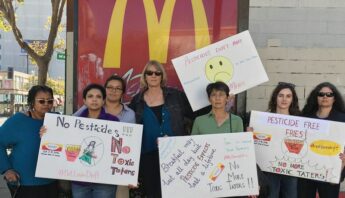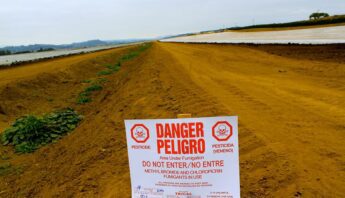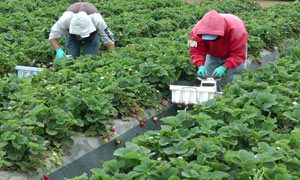For Immediate Release: June 19, 2013
Contact: Paul Towers, 916-216-1082, ptowers@panna.org
Strawberry Fumigant Pesticides Still Widely Used in California
Pesticides increasingly linked to childhood learning disabilities remain widely used on nuts, citrus and grapes
Oakland, CA – According to information released today by the California Department of Pesticide Regulation, fumigants remain the most heavily used pesticides in the state at over 50 million pounds. They also rank among the most hazardous and drift-prone, traveling from where they’re applied in the field to neighboring homes and schools. Fumigants are prevalently used in the state’s strawberry fields, and because they are likely to drift—posing health threats to those living or working nearby—state officials are increasing their support of farmers as they phase fumigants out.
In addition, pesticides linked to learning disabilities—including the brain toxicant chlorpyrifos—remain widely used on crops in the state, including nuts, citrus and grapes. Dozens of recent independent studies, as well as a recent technical report by the American Academy of Pediatrics, suggest that even in very low amounts, pesticide exposure—whether from residue on food, agricultural drift or elsewhere—can have profound and long-term effects on children’s development.
Margaret Reeves, PhD, senior scientist at Pesticide Action Network released the following statement:
“California has the most diverse and productive agricultural economy in the nation: we can and should lead the way in innovative farming practices—starting with healthy soil management. Our universities, scientists and tax dollars should now begin the work of investing in tools and techniques that will allow farmers to grow better crops with fewer chemicals. If we do this, we can have fumigant-free fields in California by 2020.
Fumigant pesticides are among the most toxic chemicals used in agriculture, they are also the most dangerous for farmworkers and nearby communities. Because soil fumigants are applied as gasses at rates of up to 400 pounds per acre this class of pesticides is nearly impossible to control. Even under the best of circumstances, they drift into neighboring communities—often landing where children are exposed to them in places that they live, learn and play.”
Emily Marquez, PhD, staff scientist at Pesticide Action Network released the following statement:
“Children across the United States are sicker today than they were a generation ago. Strong science links pesticide exposure to many childhood diseases and disorders that are on the rise. Even at very low levels, pesticide exposure can derail development and undermine the ability to learn—keeping children from reaching their full potential. For example, exposure of a developing fetus, infant or young child to low levels of neurotoxic pesticides like chlorpyrifos can result in higher rates of learning disabilities and significant drops in IQ by age seven. And over 1.2 million pounds of chlorpyrifos are used each year in California’s fields and orchards.
Changes at the household level can help, but individual actions are not the primary solution. The best way to protect children from the harms of pesticides is to dramatically reduce use nationwide. This would not only limit children’s exposure, it would also lower pesticide levels in the bodies of men and women of childbearing age—protecting current and future generations in one fell swoop. Those pesticides most harmful to children should be first on the list.”
Additional resources for editors and reporters:
- Background on fumigant pesticides and safe strawberries
- Recent PAN report: A Generation in Jeopardy: How pesticides are undermining our children’s health and intelligence
- Pesticides 101: A Primer
- Chlorpyrifos levels on commonly eaten foods







